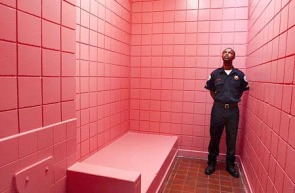Max Luscher is a Swiss psychotherapist. You might know of him through his Luscher colour test, which is an exercise where you can explore your psychophysical state through your choice of colours from his 8 tile grid. He believes that your emotional and physical condition, at the moment of taking the test, can be revealed, and from this, psychotherapeutic, or medical assistance can be put in place. He believes that we all see colour the same, but we all have personal preferences. He noted that colours are selected 'unconsciously' and thus reveal the person as they really are at that moment, not as they perceive themselves or would like to be perceived. If you take the test at different times, you will get different results, as your frame of mind will have also altered. Have a go!
How do you live with colour?
The colours that surround you affect your mind and body. If you have a red living room, you may well have more rows with your family. If you have a calming green kitchen, all will be harmonious. Why do you think we have 'Green Rooms' back stage? Green actually slows your heart rate and calms you down, so as you prepare to go on stage, stage fright is lessened. Surgeons also wear green, so that you don't pump out so much blood (and so that any splashes don't look so scary!)
Try this synaesthenic test, to explore your preferences for texture, sound, smell, etc., to see what colour palette you should have in your home.
The Colour Sense Game: What colour should your home be?
(Click this link)
 And for a bit of fun, what colour are you? What kind of colour do you exude? Are you pale and interesting, or fiery and hot? Saturated or pastel? Click the link below to have a go.
What colour are you?
And for a bit of fun, what colour are you? What kind of colour do you exude? Are you pale and interesting, or fiery and hot? Saturated or pastel? Click the link below to have a go.
What colour are you?
For all those OU U101 students working on their final design thinking assignment on 'Education', you might want to consider the effect of colour in education and the retention of learning. This links back to Rudolf Steiner's theosophy and its emphasis on synaesthesia, where all of your senses respond to stumuli whatever their nature. For example, when you hear an F Sharp played on an oboe, you will not only hear the note, but you will see colour, sense a tactile quality, and/or have a sense of its smell.
Colour theory and colour therapy were linked to this and played out in the theories of the Bauhaus (More on all of this in a later post)
Colour in learning, though, is important. Experiments were done where students tried to learn from two sets of computers. One with the normal screen surround, and the other with the surrounds painted red. The students on the red painted screens recalled far less than their peers, due to the primitive fight or flight reflex kicking in.
 What football teams are the most successful?
The ones who wear red! It makes you feel more powerful, and the opposition want to run away. It makes your heart pump faster; you have more energy and 'fight'. What colour were England wearing when we last won the World Cup?
What football teams are the most successful?
The ones who wear red! It makes you feel more powerful, and the opposition want to run away. It makes your heart pump faster; you have more energy and 'fight'. What colour were England wearing when we last won the World Cup?
 And what about our armies? Surely wearing red would make us an easy target against our green and pleasant landscape? No, actually - we scare the opposition.
Red also increases our appetite, so it's the colour of choice for fast food outlets, making us eat more and fast!
But what about other colours?
Pink? A variant of red. This has the opposite effect. 'Drunk Tank Pink' weakens the muscles, including that of the heart, even if you are colour blind. Violent prisoners are kept in pastel pink cells, groups of drunkards are thrown into Barbie Pink cells to quieten them.
West Virginia State Penitentiary had pastel cells.
And what about our armies? Surely wearing red would make us an easy target against our green and pleasant landscape? No, actually - we scare the opposition.
Red also increases our appetite, so it's the colour of choice for fast food outlets, making us eat more and fast!
But what about other colours?
Pink? A variant of red. This has the opposite effect. 'Drunk Tank Pink' weakens the muscles, including that of the heart, even if you are colour blind. Violent prisoners are kept in pastel pink cells, groups of drunkards are thrown into Barbie Pink cells to quieten them.
West Virginia State Penitentiary had pastel cells.
 For further information on this institution see Evan Meszaros' blog: http://theghostdiary.blogspot.co.uk/2011/06/lead-to-death.html
For further information on this institution see Evan Meszaros' blog: http://theghostdiary.blogspot.co.uk/2011/06/lead-to-death.html
The actual colour is referred to as Baker-Miller Pink and Dr.
Alexander Schauss, Ph.D., director of the American Institute for Biosocial
Research in Tacoma Washington, was the first to report its effects in 1981. However, it doesn't last for long. After about 15 minutes the violence comes back, so it just gives you time to calm and then separate any angry violent criminals.
And another use: If you paint your opponent's changing room Bubble Gum pink, will this mean your opposing team will lose, due to muscle weakness? Possibly. So.... in America, there is a rule that you can paint locker rooms any colour you like, as long as both the home and away team's are the same.






